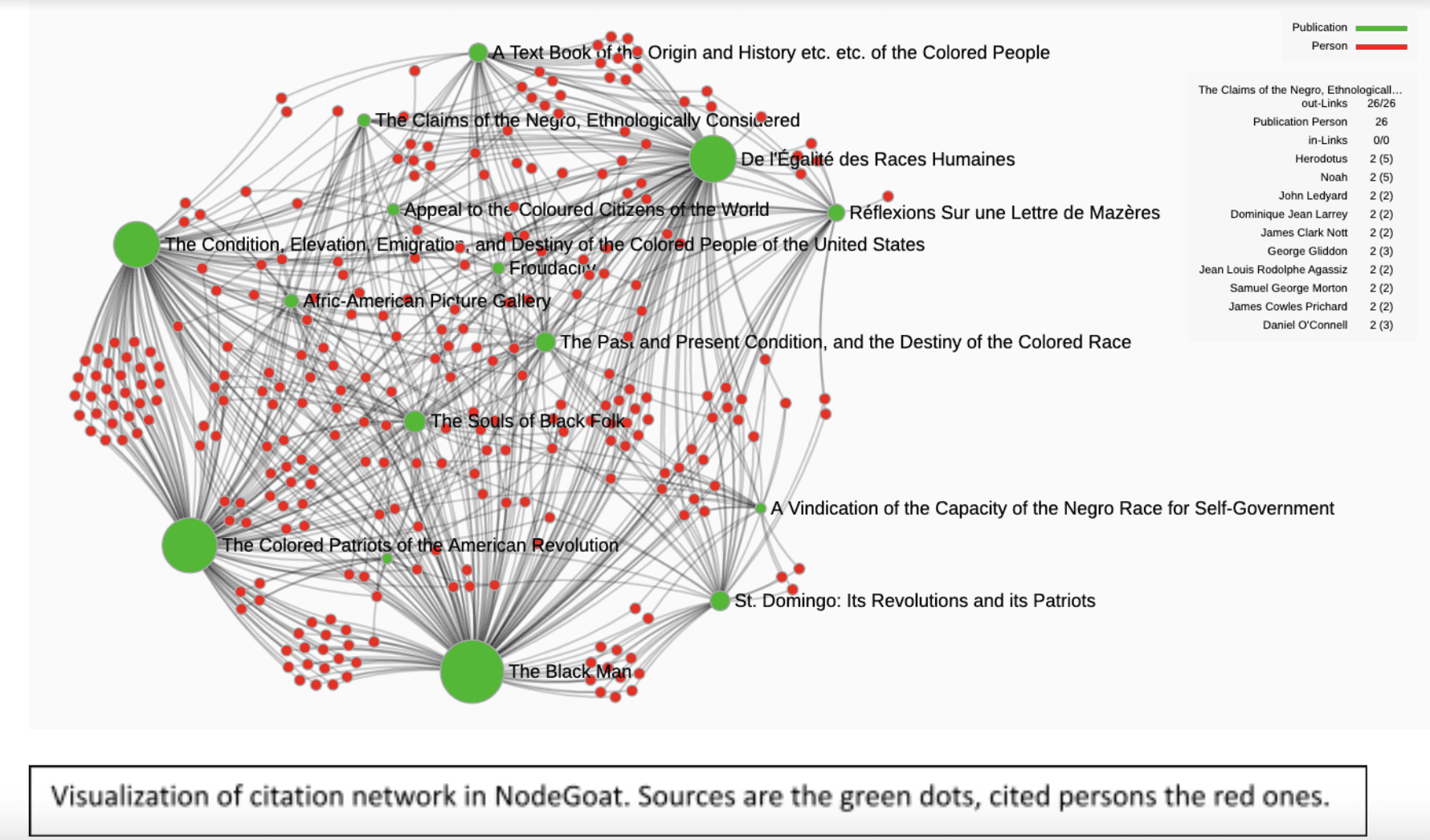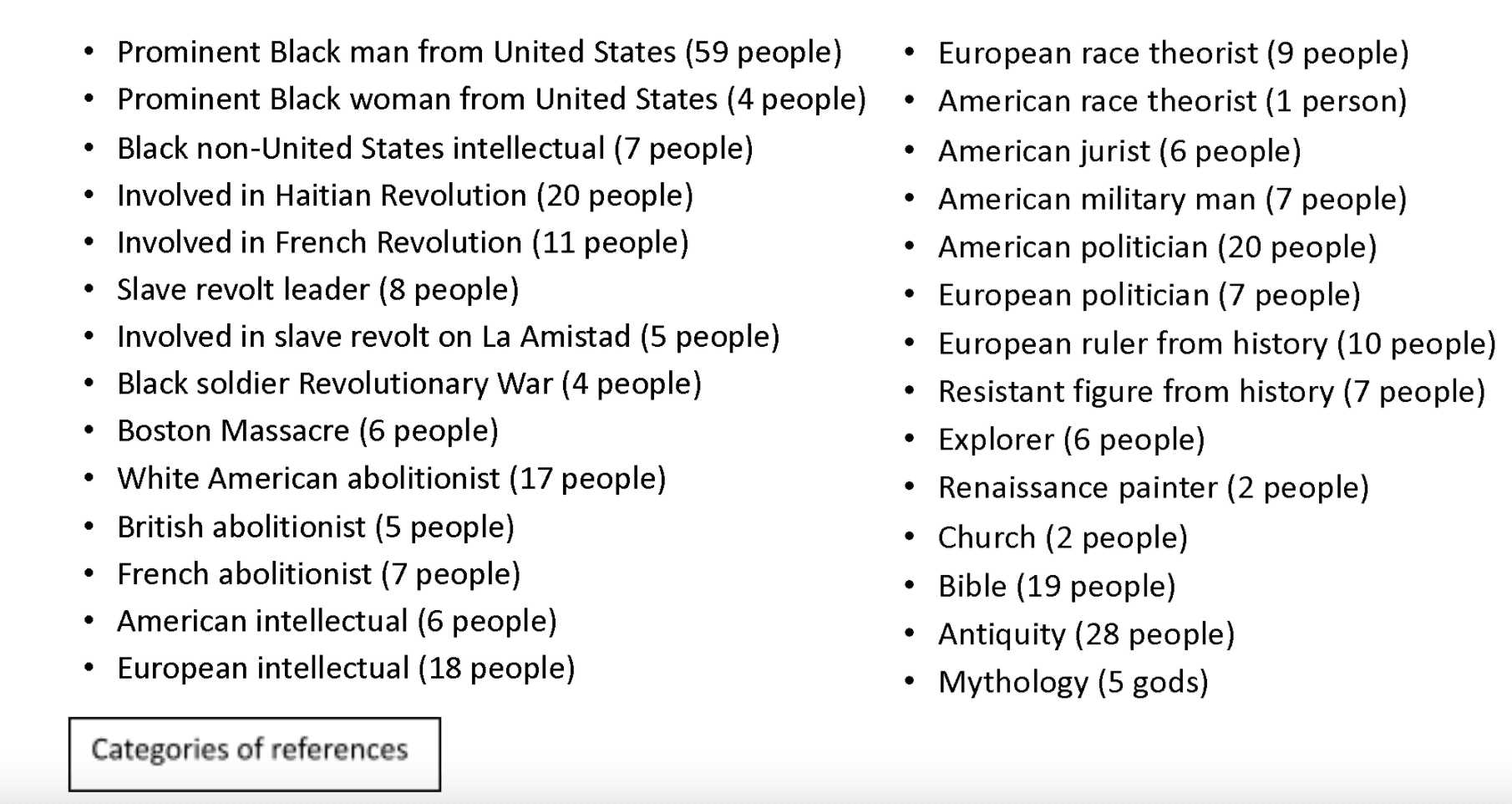Resistance Discourse of Nineteenth Century Black Intellectuals
*This post is part of our roundtable “Digital Black Atlantics.”

At the “National Negro Convention” in Buffalo of 1843, Black abolitionist and intellectual Henry Highland Garnet urged his audience to “Let your motto be RESISTANCE! RESISTANCE! RESISTANCE! – No oppressed people have ever secured their liberty without resistance.” His Address to the Slaves of the United States of America is one of fifteen nineteenth-century texts by Black intellectuals that I analyzed using digital humanities techniques. This notion of resistance was the overarching theme I found present in all of them. The network analysis I did helped reveal that a certain resistance discourse was part of the Black Atlantic.

The definition of resistance discourse that emerged from my analysis correlates to Marlene Daut’s term Black Atlantic humanism. Daut defined this form of Black intellectual thought as inspired and influenced by European humanism and the Enlightenment, but specifically anti-racist and anti-colonial. I chose to use the term resistance discourse instead, because it enabled me to put a wide array of tendencies and topics I witnessed in my sources under the same heading. The resistance discourse of the texts I analyzed manifests resistance in two ways. First, the discourse is resistant, writing in opposition to dominant Western thought or history. Second, within the resistance discourse, figures or stories of resistance were often emphasized.
I started this research because I was looking to see what potentially bound the selected authors together as a learned community: who did they cite and what did this say about possible shared frames of reference for Black intellectuals? I discussed fifteen texts by Black intellectuals discussing society, history or scholarship. Most were African American, but I also included two texts by Haitian authors – Baron de Vastey and Anténor Firmin – and one by the Trinidadian John Jacob Thomas. I read the texts and collected all the names that were cited in at least two of them. Like the other graduate students in this forum, I then used the visualization tool NodeGoat to create a citation network. All of the 275 people that were mentioned in at least two texts are visible in this network and linked to the respective sources. This visualization shows a complex web of connections, which suggests that the examined authors used common frames of reference. To make better sense of the 275 different people that were cited in two or more texts, I categorized the references by a set of criteria. These categorizations revealed how the authors of the sources I analyzed created a discourse that had resistance potential.


A major feature of how the authors of the texts I analyzed positioned themselves against Western thought can be found in the way these Black intellectuals cited ten different race theorists. They were clearly cited to be countered. Also many Black or white abolitionists, and politicians pro- and contra enslavement were mentioned in my sources. Through these references, the authors were positioning their work at the heart of the societal debate on race and slavery.
One of the trends that emerged in my analysis was how many authors cited people in the category I designated “antiquity”: historical figures who lived during the time of the ancient Greek or Roman civilizations. These numbered 28. I suspect that this is because Black authors wanted to convey a certain learnedness in the classical sense. Probably knowledge of the classics was considered to be a prerequisite to position yourself as an intellectual. Jesus Christ and other biblical figures were referenced to show that the authors were Christians with extensive knowledge of the Bible. Through their references to important European intellectuals, authors showed their knowledge of world history and the European learned community. For example, several authors mentioned William Shakespeare (1564-1616), who in three instances is mentioned simply as an important playwright and poet. However, in two sources he is remembered specifically for his play Othello, emphasizing a focus on Black identity and Black perspectives.
Many authors emphasized Black ‘heroes’ from the past or present. Two of these ‘heroes’ were early modern intellectuals: Jacobus Capitein (c. 1717-1747) and Anthony William Amo (c. 1703-c. 1759), formerly enslaved people from Africa that were educated in Europe and worked there. They were cited in three and two sources respectively. Most Black intellectuals mentioned in my sources were nineteenth-century figures: for example writer Alexandre Dumas (1802-1870), a Frenchman of Haitian descent, was mentioned in five texts. The majority of prominent Black figures that were cited, were abolitionists. A significant number of them were public intellectuals as well, who published books or articles. For example Frederick Douglass (c. 1817-1895), author of the most well-known slave narrative of his time and very active Black American political leader, appeared in eight sources.
Texts published by nineteenth-century Black intellectuals were often meant to help the abolitionist cause. The authors of the works I analyzed used a certain discourse to support their political struggle, which I have called resistance discourse. This discourse fits well within Paul Gilroy’s definition of the Black Atlantic: a trans-Atlantic counterculture to modernity produced by Black people, who are bound partly but not only by the memory of enslavement. According to Gilroy, Black Atlantic intellectual thought is indebted to modernity because it was produced within a Western framework, but it also counters it. Gilroy described how people who participate in this Black Atlantic-counterculture could feel a form of double consciousness: being a part of the West but also an outsider.
My analysis showed that Black intellectuals were concerned to write history from a Black perspective. For example Ham, in the Bible described as the forefather of the African people, was mentioned in seven texts. Also the story of Moses was often emphasized: the man who, according to the Bible, freed the enslaved Israelites in Egypt and led them to the Promised Land. The authors of my sources probably used this story to make an analogy to the contemporary situation of the Black population. Another significant way in which nineteenth-century Black intellectuals wrote history from their perspective, was by focusing on the Egyptian civilization as the African predecessor to the ancient Greek culture – the cradle of the ‘great Western civilization’. In the publications I analyzed, multiple figures from antiquity were mentioned who were either Egyptian or lived in Egypt, such as Cleopatra (69-30 BC) or Ptolemy (c. 100-c. 170 AD). Then there were figures connected to other places in North Africa, the most noteworthy one being Hannibal (247-c. 183 BC): the brave North African general who battled the mighty Roman Republic.
So, the sources showed a significant and concerted commitment to citing historical people who had something to do with resistance to oppression. This fits within the discourse of some nineteenth-century Black leaders, who explicitly called for the violent overthrow of the institutions of enslavement as the only possible solution to end it. Referring to historical precedents is a political tactic. The most important story of resistance emphasized in my sources was the story of the Haitian Revolution. Toussaint L’Ouverture (1743-1803), great leader of this revolution, is the most-cited person of my research: he was mentioned in eleven texts. Haiti served as a historical example of enslaved people winning their freedom through revolutionary violence, and the country was a huge source of inspiration as a nation led by Black people. Also other major slave revolt leaders were often cited in my sources, such as Nat Turner (c. 1800-1831), who famously led a slave rebellion in Virginia in 1831.
From an analysis of my citation network, I suggest that the authors of my sources were part of a Black learned community. Published works of nineteenth-century Black intellectuals often had a political aim: to help the abolitionist cause. The discourse which they used to support their political struggle illustrates a resistance discourse. This discourse is both resistant, countering dominant Western thought or Western-centric history, and it is a discourse on resistance: emphasising stories of battle against oppression. Its perception of learnedness is classical: authors often cited figures from antiquity, the Bible or world history in order to qualify as intellectuals. But the majority of people that were cited in my sources were in fact Black people: ‘heroes’ from the past or present. This Black learned community therefore gave its own spin on the Western tradition, also countering it. As Gilroy would have agreed upon: these Black intellectuals stood both within the West, their works being a product of it, as outside of it: fighting a common cause of resistance against the Western institutions of enslavement and the oppression of Blacks.
Copyright © AAIHS. May not be reprinted without permission.
So much to reveal and bring forward to the present age. Looking back in our history seems to accentuate our struggle today( Lack of Education & Training) continues to hold us back.
A very thought provoking article that is very informative and highlights why we had to slip and learn how to read during slavery. Please know that even today, too many of our people don’t want to do anything to try and make things better in their lives. Good article.